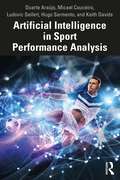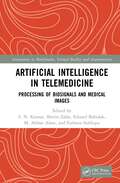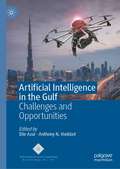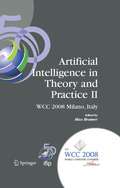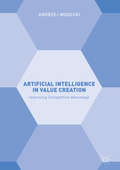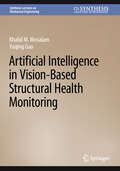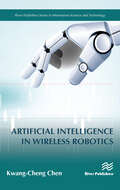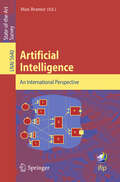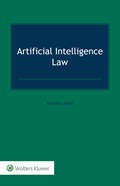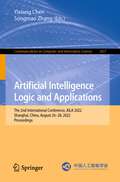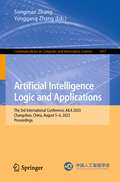- Table View
- List View
Artificial Intelligence in Schools: A Guide for Teachers, Administrators, and Technology Leaders
by Varun AroraArtificial Intelligence in Schools is the first book to explore the use of Artificial Intelligence (AI) as a tool to enhance K–12 instruction and administration. Every industry and sector will be drastically affected by the presence of artificial intelligence, and schooling is no exception! Written for the in-service community—leaders, administrators, coaches, and teachers alike—this is your one-stop opportunity to make sure you don’t fall behind the fast pace and promising innovations of today’s most advanced learning technology. Author Varun Arora presents AI as a problem-solving tool for teaching and learning, exploring its potential and application in real-world school contexts and in the language of educators. Covering curriculum development, feedback and scoring, student empowerment, behavioral and classroom management, college readiness, and more, the book is full of novel insights and concrete, strategic takeaways.
Artificial Intelligence in Schools: A Guide for Teachers, Administrators, and Technology Leaders
by Varun AroraArtificial Intelligence in Schools is the first book to explore the use of Artificial Intelligence (AI) as a tool to enhance K–12 instruction and administration. Every industry and sector will be drastically affected by the presence of artificial intelligence, and schooling is no exception! Written for the in-service community—leaders, administrators, coaches, and teachers alike—this is your one-stop opportunity to make sure you don’t fall behind the fast pace and promising innovations of today’s most advanced learning technology. Author Varun Arora presents AI as a problem-solving tool for teaching and learning, exploring its potential and application in real-world school contexts and in the language of educators. Covering curriculum development, feedback and scoring, student empowerment, behavioral and classroom management, college readiness, and more, the book is full of novel insights and concrete, strategic takeaways.
Artificial Intelligence in Sport Performance Analysis
by Duarte Araújo Micael S Couceiro Ludovic Seifert Hugo Sarmento Keith DavidsTo understand the dynamic patterns of behaviours and interactions between athletes that characterize successful performance in different sports is an important challenge for all sport practitioners. This book guides the reader in understanding how an ecological dynamics framework for use of artificial intelligence (AI) can be implemented to interpret sport performance and the design of practice contexts. By examining how AI methodologies are utilized in team games, such as football, as well as in individual sports, such as golf and climbing, this book provides a better understanding of the kinematic and physiological indicators that might better capture athletic performance by looking at the current state-of-the-art AI approaches. Artificial Intelligence in Sport Performance Analysis provides an all-encompassing perspective in an innovative approach that signals practical applications for both academics and practitioners in the fields of coaching, sports analysis, and sport science, as well as related subjects such as engineering, computer and data science, and statistics.
Artificial Intelligence in Sport Performance Analysis
by Duarte Araújo Micael S Couceiro Ludovic Seifert Hugo Sarmento Keith DavidsTo understand the dynamic patterns of behaviours and interactions between athletes that characterize successful performance in different sports is an important challenge for all sport practitioners. This book guides the reader in understanding how an ecological dynamics framework for use of artificial intelligence (AI) can be implemented to interpret sport performance and the design of practice contexts. By examining how AI methodologies are utilized in team games, such as football, as well as in individual sports, such as golf and climbing, this book provides a better understanding of the kinematic and physiological indicators that might better capture athletic performance by looking at the current state-of-the-art AI approaches. Artificial Intelligence in Sport Performance Analysis provides an all-encompassing perspective in an innovative approach that signals practical applications for both academics and practitioners in the fields of coaching, sports analysis, and sport science, as well as related subjects such as engineering, computer and data science, and statistics.
Artificial Intelligence in Telemedicine: Processing of Biosignals and Medical images (Innovations in Multimedia, Virtual Reality and Augmentation)
by S. N. Kumar Sherin Zafar Eduard Babulak M. Afshar Alam Farheen SiddiquiThis book explores the role of artificial Intelligence in Telemedicine. It explains the concepts through the detailed study and processing of biosignals, physiological parameters, and medical images. The book focuses on computational algorithms in telemedicine for the processing of biosignals, physiological parameters, and medical Images. The book is presented in two section. The first section presents the role of computational algorithms in the processing of biosignal and medical images for disease diagnosis and treatment planning. Noise removal in ECG signal using an improved adaptive learning approach, classification of ECG signals using CNN for cardiac arrhythmia detection, EEG signal analysis for stroke detection, and EMG signal analysis for gesture classification were discussed in this section. Application of CNN in pertussis Diagnosis by temperature monitoring, physician handwriting recognition using deep learning model, melanoma detection using ABCD parameters, and transfer learning enabled heuristic approach for pneumonia detection was also discussed in this section The second section focus on the role of IoT and artificial intelligence in the healthcare sector. IoT in smart health care and applications of artificial intelligence in disease diagnosis and prediction was discussed in this section. The importance of 5G/6G in the pandemic scenario for telemedicine applications, wireless capsule endoscopy image compression, leukemia detection from the microscopic cell images, and genomic signal processing using numerical mapping techniques was also discussed in this section. This book can be used by a wide range of users including students, research scholars, faculty, and practitioners in the field of engineering for applications in biomedical signal, image analysis, and diagnosis.
Artificial Intelligence in Telemedicine: Processing of Biosignals and Medical images (Innovations in Multimedia, Virtual Reality and Augmentation)
This book explores the role of artificial Intelligence in Telemedicine. It explains the concepts through the detailed study and processing of biosignals, physiological parameters, and medical images. The book focuses on computational algorithms in telemedicine for the processing of biosignals, physiological parameters, and medical Images. The book is presented in two section. The first section presents the role of computational algorithms in the processing of biosignal and medical images for disease diagnosis and treatment planning. Noise removal in ECG signal using an improved adaptive learning approach, classification of ECG signals using CNN for cardiac arrhythmia detection, EEG signal analysis for stroke detection, and EMG signal analysis for gesture classification were discussed in this section. Application of CNN in pertussis Diagnosis by temperature monitoring, physician handwriting recognition using deep learning model, melanoma detection using ABCD parameters, and transfer learning enabled heuristic approach for pneumonia detection was also discussed in this section The second section focus on the role of IoT and artificial intelligence in the healthcare sector. IoT in smart health care and applications of artificial intelligence in disease diagnosis and prediction was discussed in this section. The importance of 5G/6G in the pandemic scenario for telemedicine applications, wireless capsule endoscopy image compression, leukemia detection from the microscopic cell images, and genomic signal processing using numerical mapping techniques was also discussed in this section. This book can be used by a wide range of users including students, research scholars, faculty, and practitioners in the field of engineering for applications in biomedical signal, image analysis, and diagnosis.
Artificial Intelligence in the Gulf: Challenges and Opportunities
by Elie Azar Anthony N. HaddadThis book presents the first broad reflection on the challenges, opportunities, and implications of Artificial Intelligence (AI) in the Gulf Cooperation Council (GCC). Unique results and insights are derived through case studies from diverse disciplines, including engineering, economics, data science, policy-making, governance, and humanscience. Particularly related to these ‘softer’ disciplines, we make some unexplored yet topical contributions to the literature, with a focus on the GCC (but by no means limited to it), including AI and implications for women, Islamic schools of thought on AI, and the power of AI to help deliver wellbeing and happiness in cities and urban spaces. Finally, the readers are provided with a synthesis of ideas, lessons learned, and a path forward based on the diverse content of the chapters. The book caters to the educated non specialist with interest in AI, targeting a wide audience including professionals, academics, government officials, policymakers, entrepreneurs, and non-governmental organizations.
Artificial Intelligence in Theory and Practice: IFIP 19th World Computer Congress, TC 12: IFIP AI 2006 Stream, August 21-24, 2006, Santiago, Chile (IFIP Advances in Information and Communication Technology #217)
by Max BramerThe papers in this volume comprise the refereed proceedings of the conference 'Artificial Intelligence in Theory and Practice' (IFIP AI 2006), which formed part of the 19th World Computer Congress of IFIP, the International Federation for Information Processing (WCC- 2006), in Santiago, Chile in August 2006. The conference is organised by the IFIP Technical Committee on Artificial Intelligence (Technical Committee 12) and its Working Group 12.5 (Artificial Intelligence Applications). All papers were reviewed by at least two members of our Programme Committee. The best papers were selected for the conference and are included in this volume. The international nature of IFIP is amply reflected in the large number of countries represented here. The conference featured invited talks by Rose Dieng, John Atkinson, John Debenham and myself. IFIP AI 2006 also included the Second IFIP Symposium on Professional Practice in Artificial Intelligence, organised by Professor John Debenham, which ran alongside the refereed papers. I should like to thank the conference chair. Professor Debenham for all his efforts in organising the Symposium and the members of our programme committee for reviewing an unexpectedly large number of papers to a very tight deadline. This is the latest in a series of conferences organised by IFIP Technical Committee 12 dedicated to the techniques of Artificial Intelligence and their real-world applications. The wide range and importance of these applications is clearly indicated by the papers in this volume. Further information about TCI 2 can be found on our website http://www.ifiptcl2.org.
Artificial Intelligence in Theory and Practice II: IFIP 20th World Computer Congress, TC 12: IFIP AI 2008 Stream, September 7-10, 2008, Milano, Italy (IFIP Advances in Information and Communication Technology #276)
by Max BramerThe papers in this volume comprise the refereed proceedings of the conference ‘ Artificial Intelligence in Theory and Practice’ (IFIP AI 2008), which formed part of the 20th World Computer Congress of IFIP, the International Federation for Information Processing (WCC-2008), in Milan, Italy in September 2008. The conference is organised by the IFIP Technical Committee on Artificial Intelligence (Technical Committee 12) and its Working Group 12.5 (Artificial Intelligence Applications). All papers were reviewed by at least two members of our Program Committee. Final decisions were made by the Executive Program Committee, which comprised John Debenham (University of Technology, Sydney, Australia), Ilias Maglogiannis (University of Aegean, Samos, Greece), Eunika Mercier-Laurent (KIM, France) and myself. The best papers were selected for the conference, either as long papers (maximum 10 pages) or as short papers (maximum 5 pages) and are included in this volume. The international nature of IFIP is amply reflected in the large number of countries represented here. The conference also featured invited talks by Prof. Nikola Kasabov (Auckland University of Technology, New Zealand) and Prof. Lorenza Saitta (University of Piemonte Orientale, Italy). I should like to thank the conference chair, John Debenham for all his efforts and the members of our program committee for reviewing papers to a very tight deadline.
Artificial Intelligence in Theory and Practice III: Third IFIP TC 12 International Conference on Artificial Intelligence, IFIP AI 2010, Held as Part of WCC 2010, Brisbane, Australia, September 20-23, 2010, Proceedings (IFIP Advances in Information and Communication Technology #331)
by Max BramerThe papers in this volume comprise the refereed proceedings of the conference Arti- cial Intelligence in Theory and Practice (IFIP AI 2010), which formed part of the 21st World Computer Congress of IFIP, the International Federation for Information Pr- essing (WCC-2010), in Brisbane, Australia in September 2010. The conference was organized by the IFIP Technical Committee on Artificial Int- ligence (Technical Committee 12) and its Working Group 12.5 (Artificial Intelligence Applications). All papers were reviewed by at least two members of our Program Committee. - nal decisions were made by the Executive Program Committee, which comprised John Debenham (University of Technology, Sydney, Australia), Ilias Maglogiannis (University of Central Greece, Lamia, Greece), Eunika Mercier-Laurent (KIM, France) and myself. The best papers were selected for the conference, either as long papers (maximum 10 pages) or as short papers (maximum 5 pages) and are included in this volume. The international nature of IFIP is amply reflected in the large number of countries represented here. I should like to thank the Conference Chair, Tharam Dillon, for all his efforts and the members of our Program Committee for reviewing papers under a very tight de- line.
Artificial Intelligence in Theory and Practice IV: 4th IFIP TC 12 International Conference on Artificial Intelligence, IFIP AI 2015, Held as Part of WCC 2015, Daejeon, South Korea, October 4-7, 2015, Proceedings (IFIP Advances in Information and Communication Technology #465)
by Tharam DillonThis book constitutes the refereed proceedings of the 4th IFIP TC 12 International Conference on Artificial Intelligence, IFIP AI 2015, Held as Part of WCC 2015, in Daejeon, South Korea, in October 2015. The 13 full papers presented were carefully reviewed and selected from 36 submissions. The papers are organized in topical sections on artificial intelligence techniques in biomedicine, artificial intelligence for knowledge management, computational intelligence and algorithms, and intelligent decision support systems.
Artificial Intelligence in Value Creation: Improving Competitive Advantage
by Andrzej WodeckiThis book analyses various models of value creation in projects and businesses by applying different forms of Artificial Intelligence in their products and services. First presenting the main concepts and ideas behind AI, Wodecki assesses different models of technology-based value creation based upon the analysis of over 400 case studies. This framework shows how AI may influence both value creation and competitive advantage (efficiency, creativity and flexibility) within a modern organization. Finally, a conceptual model is formulated to evaluate AI-supported in-company projects and new ventures and identify the key managerial and technical competencies required.
Artificial Intelligence in Vision-Based Structural Health Monitoring (Synthesis Lectures on Mechanical Engineering)
by Khalid M. Mosalam Yuqing GaoThis book provides a comprehensive coverage of the state-of-the-art artificial intelligence (AI) technologies in vision-based structural health monitoring (SHM). In this data explosion epoch, AI-aided SHM and rapid damage assessment after natural hazards have become of great interest in civil and structural engineering, where using machine and deep learning in vision-based SHM brings new research direction. As researchers begin to apply these concepts to the structural engineering domain, especially in SHM, several critical scientific questions need to be addressed: (1) What can AI solve for the SHM problems? (2) What are the relevant AI technologies? (3) What is the effectiveness of the AI approaches in vision-based SHM? (4) How to improve the adaptability of the AI approaches for practical projects? (5) How to build a resilient AI-aided disaster prevention system making use of the vision-based SHM? This book introduces and implements the state-of-the-art machine learning and deep learning technologies for vision-based SHM applications. Specifically, corresponding to the above-mentioned scientific questions, it consists of: (1) motivation, background & progress of AI-aided vision-based SHM, (2) fundamentals of machine learning & deep learning approaches, (3) basic AI applications in vision-based SHM, (4) advanced topics & approaches, and (5) resilient AI-aided applications. In the introduction, a brief coverage about the development progress of AI technologies in the vision-based area is presented. It gives the readers the motivations and background of the relevant research. In Part I, basic knowledges of machine and deep learning are introduced, which provide the foundation for the readers irrespective of their background. In Part II, to verify the effectiveness of the AI methods, the key procedure of the typical AI-aided SHM applications (classification, localization, and segmentation) is explored, including vision data collection, data pre-processing,transfer learning-based training mechanism, evaluation, and analysis. In Part III, advanced AI topics, e.g., generative adversarial network, semi-supervised learning, and active learning, are discussed. They aim to address several critical issues in practical projects, e.g., the lack of well-labeled data and imbalanced labels, to improve the adaptability of the AI models. In Part IV, the new concept of “resilient AI” is introduced to establish an intelligent disaster prevention system, multi-modality learning, multi-task learning, and interpretable AI technologies. These advances are aimed towards increasing the robustness and explainability of the AI-enabled SHM system, and ultimately leading to improved resiliency.The scope covered in this book is not only beneficial for education purposes but also is essential for modern industrial applications. The target audience is broad and includes students, engineers, and researchers in civil engineering, statistics, and computer science. Unique Book Features:• Provide a comprehensive review of the rapidly expanding field of vision-based structural health monitoring (SHM) using artificial intelligence approaches. • Re-organize fundamental knowledge specific to the machine and deep learning in vision tasks.• Include comprehensive details about the procedure of conducting AI approaches for vision-based SHM along with examples and exercises.• Cover a vast array of special topics and advanced AI-enabled vision-based SHM applications.• List a few potential extensions for inspiring the readers for future investigation.
Artificial Intelligence in Wireless Robotics
by Kwang-Cheng ChenRobots, autonomous vehicles, unmanned aerial vehicles, and smart factory, will significantly change human living style in digital society. Artificial Intelligence in Wireless Robotics introduces how wireless communications and networking technology enhances facilitation of artificial intelligence in robotics, which bridges basic multi-disciplinary knowledge among artificial intelligence, wireless communications, computing, and control in robotics. A unique aspect of the book is to introduce applying communication and signal processing techniques to enhance traditional artificial intelligence in robotics and multi-agent systems.The technical contents of this book include fundamental knowledge in robotics, cyber-physical systems, artificial intelligence, statistical decision and Markov decision process, reinforcement learning, state estimation, localization, computer vision and multi-modal data fusion, robot planning, multi-agent systems, networked multi-agent systems, security and robustness of networked robots, and ultra-reliable and low-latency machine-to-machine networking. Examples and exercises are provided for easy and effective comprehension.Engineers wishing to extend knowledge in the robotics, AI, and wireless communications, would be benefited from this book. In the meantime, the book is ready as a textbook for senior undergraduate students or first-year graduate students in electrical engineering, computer engineering, computer science, and general engineering students. The readers of this book shall have basic knowledge in undergraduate probability and linear algebra, and basic programming capability, in order to enjoy deep reading.
Artificial Intelligence in Wireless Robotics
by Kwang-Cheng ChenRobots, autonomous vehicles, unmanned aerial vehicles, and smart factory, will significantly change human living style in digital society. Artificial Intelligence in Wireless Robotics introduces how wireless communications and networking technology enhances facilitation of artificial intelligence in robotics, which bridges basic multi-disciplinary knowledge among artificial intelligence, wireless communications, computing, and control in robotics. A unique aspect of the book is to introduce applying communication and signal processing techniques to enhance traditional artificial intelligence in robotics and multi-agent systems.The technical contents of this book include fundamental knowledge in robotics, cyber-physical systems, artificial intelligence, statistical decision and Markov decision process, reinforcement learning, state estimation, localization, computer vision and multi-modal data fusion, robot planning, multi-agent systems, networked multi-agent systems, security and robustness of networked robots, and ultra-reliable and low-latency machine-to-machine networking. Examples and exercises are provided for easy and effective comprehension.Engineers wishing to extend knowledge in the robotics, AI, and wireless communications, would be benefited from this book. In the meantime, the book is ready as a textbook for senior undergraduate students or first-year graduate students in electrical engineering, computer engineering, computer science, and general engineering students. The readers of this book shall have basic knowledge in undergraduate probability and linear algebra, and basic programming capability, in order to enjoy deep reading.
The Artificial Intelligence Infrastructure Workshop: Build your own highly scalable and robust data storage systems that can support a variety of cutting-edge AI applications
by Gareth Dwyer Chinmay Arankalle Bas Geerdink Kunal Gera Kevin Liao Anand N.S.Explore how a data storage system works – from data ingestion to representationKey FeaturesUnderstand how artificial intelligence, machine learning, and deep learning are different from one anotherDiscover the data storage requirements of different AI apps using case studiesExplore popular data solutions such as Hadoop Distributed File System (HDFS) and Amazon Simple Storage Service (S3)Book DescriptionSocial networking sites see an average of 350 million uploads daily - a quantity impossible for humans to scan and analyze. Only AI can do this job at the required speed, and to leverage an AI application at its full potential, you need an efficient and scalable data storage pipeline. The Artificial Intelligence Infrastructure Workshop will teach you how to build and manage one.The Artificial Intelligence Infrastructure Workshop begins taking you through some real-world applications of AI. You'll explore the layers of a data lake and get to grips with security, scalability, and maintainability. With the help of hands-on exercises, you'll learn how to define the requirements for AI applications in your organization. This AI book will show you how to select a database for your system and run common queries on databases such as MySQL, MongoDB, and Cassandra. You'll also design your own AI trading system to get a feel of the pipeline-based architecture. As you learn to implement a deep Q-learning algorithm to play the CartPole game, you'll gain hands-on experience with PyTorch. Finally, you'll explore ways to run machine learning models in production as part of an AI application.By the end of the book, you'll have learned how to build and deploy your own AI software at scale, using various tools, API frameworks, and serialization methods.What you will learnGet to grips with the fundamentals of artificial intelligenceUnderstand the importance of data storage and architecture in AI applicationsBuild data storage and workflow management systems with open source toolsContainerize your AI applications with tools such as DockerDiscover commonly used data storage solutions and best practices for AI on Amazon Web Services (AWS)Use the AWS CLI and AWS SDK to perform common data tasksWho this book is forIf you are looking to develop the data storage skills needed for machine learning and AI and want to learn AI best practices in data engineering, this workshop is for you. Experienced programmers can use this book to advance their career in AI. Familiarity with programming, along with knowledge of exploratory data analysis and reading and writing files using Python will help you to understand the key concepts covered.
Artificial Intelligence. An International Perspective: An International Perspective (Lecture Notes in Computer Science #5640)
by Max BramerArtificial Intelligence (AI) is a rapidly growing inter-disciplinary field with a long and distinguished history that involves many countries and considerably pre-dates the development of computers. It can be traced back at least as far as Ancient Greece and has evolved over time to become a major subfield of computer science in general. This state-of-the-art survey not only serves as a "position paper" on the field from the viewpoint of expert members of the IFIP Technical Committee 12, its Working Groups and their colleagues, but also presents overviews of current work in different countries. The chapters describe important relatively new or emerging areas of work in which the authors are personally involved, including text and hypertext categorization; autonomous systems; affective intelligence; AI in electronic healthcare systems; artifact-mediated society and social intelligence design; multilingual knowledge management; agents, intelligence and tools; intelligent user profiling; and supply chain business intelligence. They provide an interesting international perspective on where this significant field is going at the end of the first decade of the twenty-first century.
Artificial Intelligence, Internet of Things (Smart Engineering Systems)
by Mohan Lal Kolhe Kailash J. Karande Sampat G. DeshmukhThis reference text offers the reader a comprehensive insight into recent research breakthroughs in blockchain, the Internet of Things (IoT), artificial intelligence and material structure and hybrid technologies in their integrated platform, while also emphasizing their sustainability aspects. The text begins by discussing recent advances in energy materials and energy conversion materials using machine learning, as well as recent advances in optoelectronic materials for solar energy applications. It covers important topics including advancements in electrolyte materials for solid oxide fuel cells, advancements in composite materials for Li-ion batteries, progression of materials for supercapacitor applications, and materials progression for thermochemical storage of low-temperature solar thermal energy systems. This book: Discusses advances in blockchain, the Internet of Things, artificial intelligence, material structure and hybrid technologies Covers intelligent techniques in materials progression for sensor development and energy material characterization using signal processing Examines the integration of phase change materials in construction for thermal energy regulation in new buildings Explores the current happenings in technology in conjunction with basic laws and mathematical models Connecting advances in engineering materials with the use of smart techniques including artificial intelligence, machine learning and Internet of Things (IoT) in a single volume, this text will be especially useful for graduate students, academic researchers and professionals in the fields of electrical engineering, electronics engineering, materials science, mechanical engineering and computer science.
Artificial Intelligence, Internet of Things (Smart Engineering Systems)
by Lal Kolhe MohanThis reference text offers the reader a comprehensive insight into recent research breakthroughs in blockchain, the Internet of Things (IoT), artificial intelligence and material structure and hybrid technologies in their integrated platform, while also emphasizing their sustainability aspects. The text begins by discussing recent advances in energy materials and energy conversion materials using machine learning, as well as recent advances in optoelectronic materials for solar energy applications. It covers important topics including advancements in electrolyte materials for solid oxide fuel cells, advancements in composite materials for Li-ion batteries, progression of materials for supercapacitor applications, and materials progression for thermochemical storage of low-temperature solar thermal energy systems. This book: Discusses advances in blockchain, the Internet of Things, artificial intelligence, material structure and hybrid technologies Covers intelligent techniques in materials progression for sensor development and energy material characterization using signal processing Examines the integration of phase change materials in construction for thermal energy regulation in new buildings Explores the current happenings in technology in conjunction with basic laws and mathematical models Connecting advances in engineering materials with the use of smart techniques including artificial intelligence, machine learning and Internet of Things (IoT) in a single volume, this text will be especially useful for graduate students, academic researchers and professionals in the fields of electrical engineering, electronics engineering, materials science, mechanical engineering and computer science.
Artificial Intelligence, Internet of Things, and Society 5.0 (Studies in Computational Intelligence #1113)
by Azzam Hannoon Abdullah MahmoodThis book unlike any other previous book provides a platform for scholars and researchers to present the latest insights and findings on the application of artificial intelligence and other sustainable technologies for a human-centric society. It brings together technology with society with special attention given to AI and IoT-related intricacies for a digital economy. It covers a variety of research topics including block ciphers, network marketing for sustainability entrepreneurship and AI, AI and stock trading decisions, digital transformation, knowledge management, chatbot engineering, cybersecurity, and smart metering system. The book is a comprehensive reference work for scholars, academics, policymakers, students, and professionals presenting an overall understanding of AI, its present and future trends, and presents a discourse on important policies and strategies on inclusivity, diversity, bias, accountability, security, metaverse applications of AI, and other technologies such as IoT.
Artificial Intelligence: Its Scope and Limits (Studies in Cognitive Systems #4)
by J.H. FetzerThis series will include monographs and collections of studies devoted to the investigation and exploration of knowledge, information, and data processing systems of all kinds, no matter whether human, (other) animal, or machine. Its scope is intended to span the full range of interests from classical problems in the philosophy of mind and philosophical psycholo gy through issues in cognitive psychology and sociobiology (concerning the mental capabilities of other species) to ideas related to artificial in telligence and to computer science. While primary emphasis will be placed upon theoretical, conceptual, and epistemological aspects of these prob lems and domains, empirical, experimental, and methodological studies will also appear from time to time. The perspective that prevails in artificial intelligence today suggests that the theory of computability defines the boundaries of the nature of thought, precisely because all thinking is computational. This paradigm draws its inspiration from the symbol-system hypothesis of Newell and Simon and finds its culmination in the computational conception of lan guage and mentality. The "standard conception" represented by these views is subjected to a thorough and sustained critique in the pages of this book. Employing a distinction between systems for which signs are signif icant for the users of a system and others for which signs are significant for use by a system, I have sought to define the boundaries of what AI, in principle, may be expected to achieve.
Artificial Intelligence IV: Methodology, Systems, Applications
by P. Jorrand V. SgurevPresenting recent results and ongoing research in Artificial Intelligence, this book has a strong emphasis on fundamental questions in several key areas: programming languages, automated reasoning, natural language processing and computer vision.AI is at the source of major programming language design efforts. Different approaches are described, with some of their most significant results: languages combining logic and functional styles, logic and parallel, functional and parallel, logic with constraints.A central problem in AI is automated reasoning, and formal logic is, historically, at the root of research in this domain. This book presents results in automatic deduction, non-monotonic reasoning, non-standard logic, machine learning, and common-sense reasoning. Proposals for knowledge representation and knowledge engineering are described and the neural net challenger to classical symbolic AI is also defended.Finally, AI systems must be able to interact with their environment in a natural and autonomous way. Natural language processing is an important part of this. Various results are presented in discourse planning, natural language parsing, understanding and generation. The autonomy of a machine for perception of its physical environment is also an AI problem and some research in image processing and computer vision is described.
Artificial Intelligence Law
by Edward SwanIt is inevitable, given the enormous media-driven concern generated by the recent application of artificial intelligence (AI) to an ever-expanding spectrum of day-to-day human experience, that the need for a clearly articulated legal response has become imperative. This book both clarifies the controversial issues surrounding the use of AI and explores in great detail how, far from being “unregulated,” the creation, distribution, and operation of AI systems currently is, and will remain, subject to a vast array of existing laws and regulations all over the world. Demonstrating beyond any doubt that the traditional concepts of legal responsibility, including duty of care, negligence, and compensation for damages, will always be applicable to those humans who create and/or use artificially intelligent things or systems, the author shows how AI systems are clearly implicated in numerous existing legal regimes, including the following: relevant provisions under international law and EU law; applicable provisions in the laws of the United States, the United Kingdom, France, China, India, Japan, South Korea, and Singapore; and numerous national provisions in the legal fields of health and safety, intellectual property, competition, privacy and data protection, and military engagement. However, given the lack of international consensus on this vitally important issue, the author suggests that any worldwide agreement on the legal responsibilities relating to the use of AI will need to be carefully defined, and that provisions will need to be reviewed to determine how they will apply to any new range of artificially intelligent creations. The purpose of this book is to review those legal concepts, throughout the world, that currently govern the application of AI and to comment on modifications or extensions of the rule of law that are being proposed as necessary to serve and protect humanity in relation to the expanding applications of AI. It is important that anyone who uses or is affected by AI products understands the relationship between existing laws and regulations in major markets around the world and those areas where initial regulations may be required. For them, for their counsel, and for the various policy and regulatory authorities confronted with AI issues, this book will prove an essential guide.
Artificial Intelligence Logic and Applications: The 2nd International Conference, AILA 2022, Shanghai, China, August 26–28, 2022, Proceedings (Communications in Computer and Information Science #1657)
by Songmao Zhang Yixiang ChenThis book constitutes refereed proceedings of the 2nd International Conference on Artificial Intelligence Logic and Applications 2022 held in Shanghai, China from August 26–28, 2022.The 20 full papers presented in this volume were carefully reviewed and selected from a total of 27 submissions. The papers in the volume are organised according to the following topical headings: program logic; fuzzy logic; applications; author index.
Artificial Intelligence Logic and Applications: The 3rd International Conference, AILA 2023, Changchun, China, August 5–6, 2023, Proceedings (Communications in Computer and Information Science #1917)
by Songmao Zhang Yonggang ZhangThis book constitutes the proceedings of the Third International Conference, AILA 2023, held in Changchun, China, during August 5–6, 2023. The 26 full papers and the 10 short papers included in this volume were carefully reviewed and selected from 56 submissions. This volume aims to provide novel ideas, original research achievements, and practical experiences in a broad range of artificial intelligence logic and applications.

